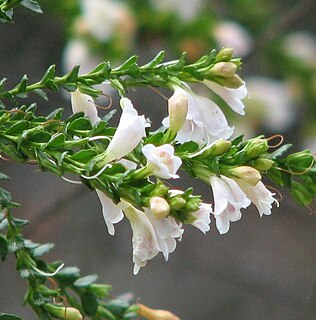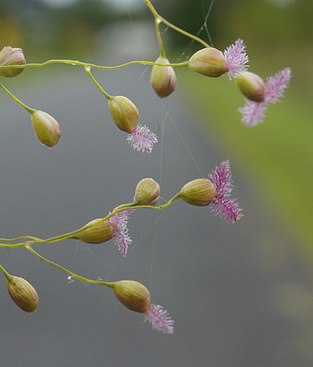
Western Australia is a state occupying the entire western third of Australia. It is bounded by the Indian Ocean to the north and west, and the Southern Ocean to the south, the Northern Territory to the north-east, and South Australia to the south-east. Western Australia is Australia's largest state, with a total land area of 2,529,875 square kilometres, and the second-largest country subdivision in the world, surpassed only by Russia's Sakha Republic. The state has about 2.6 million inhabitants – around 11 percent of the national total – of whom the vast majority live in the south-west corner, 79 per cent of the population living in the Perth area, leaving the remainder of the state sparsely populated.
![<i>Banksia</i> A diverse genus of exquisitely flowered Australian [[Proteaceae]].](https://upload.wikimedia.org/wikipedia/commons/thumb/5/5f/Banksia_in_the_Blue_Mountains.jpg/320px-Banksia_in_the_Blue_Mountains.jpg)
Banksia is a genus of around 170 species in the plant family Proteaceae. These Australian wildflowers and popular garden plants are easily recognised by their characteristic flower spikes and fruiting "cones" and heads. Banksias range in size from prostrate woody shrubs to trees up to 30 metres tall. They are found in a wide variety of landscapes; sclerophyll forest, (occasionally) rainforest, shrubland, and some more arid landscapes, though not in Australia's deserts.

Bunbury is a coastal city in the Australian state of Western Australia, approximately 175 kilometres (109 mi) south of the state capital, Perth. It is the state's third-largest city, with a population just behind that of Mandurah.

Eucalyptus diversicolor, commonly known as the karri, is a eucalypt native to the wetter regions of southwestern Western Australia.

Mukinbudin is a small town in the North Eastern Wheatbelt region of Western Australia, approximately 298 kilometres (185 mi) east of Perth and 80 kilometres (50 mi) north of Merredin near Lake Campion. It is the main town in the Shire of Mukinbudin. At the 2006 census, Mukinbudin had a population of 281.

Banksia tricuspis, commonly known as Lesueur banksia or pine banksia, is a plant in the family Proteaceae and is endemic to a small area in the south-west of Western Australia. It is a stunted tree or shrub with narrow leaves and cylindrical spikes of golden-coloured flowers and it occurs in a geographic range of just 15 square kilometres near Jurien.

Chamelaucium, also known as waxflower, is a genus of shrubs endemic to south western Western Australia. They belong to the myrtle family Myrtaceae and have flowers similar to those of the tea-trees (Leptospermum). The most well-known species is the Geraldton Wax, Chamelaucium uncinatum, which is cultivated widely for its large attractive flowers.

Phebalium is a genus of shrubs in the family Rutaceae, endemic to Australia. A number of species formerly included within this genus have been transferred to the genera Leionema and Nematolepis.

The Western Australia Australian rules football team is the state representative side of Western Australia in the sport of Australian rules football.

Eremophila brevifolia, also known as spotted eremophila, is a flowering plant in the figwort family, Scrophulariaceae and is endemic to the south-west of Western Australia. It is an erect, open, spindly shrub with sticky, short, serrated leaves and white to pink flowers and is only known from a few scattered populations.

Balsamocarpon brevifolium, or algarrobilla, is a species of flowering plants in the legume family, Fabaceae. It belongs to the subfamily Caesalpinioideae and is found in Chile.

Isachne is a widespread genus of tropical and subtropical plants in the grass family, found in Asia, Africa, Australia, the Americas, and various oceanic islands. They may be known generally as bloodgrasses.
Malayali Australians are Australians whose ancestors, or themselves identify as ethnic Malayali's and speak Malayalam language. Malayali Australians constitute one group of Indian Australians. Malayali's originate from the South Indian state of Kerala, and is one of the fastest growing populations in Australia, with 53,206 speakers as per 2016 census. There were 25,111 Malayali's in Australia according to 2011 census. Majority of this population has arrived in Australia after the year 2007. The state and territory wise breakup of Malayalam speakers as per 2016 census is:

Persoonia falcata, commonly known as the wild pear, is a shrub native to northern Australia.
Ripogonum brevifolium, commonly known as small–leaved supplejack, is a vine, or sometimes a shrub, native to Australia.
Cirsium brevifolium is a North American species of plants in the thistle tribe within the sunflower family. Common name is Palouse thistle. The species is native to the northwestern United States, in the States of Washington, Oregon, and Idaho. The plant is particularly common in the Palouse Prairie near Pullman, Washington.
Helenium brevifolium is a North American perennial plant in the Sunflower Family, commonly known as Shortleaf sneezeweed. It is native to the southeastern United States, from Virginia to eastern Louisiana and inland as far as Tennessee.

Persoonia sulcata is a plant in the family Proteaceae and is endemic to the south-west of Western Australia. It is a small, erect or low spreading shrub with narrow, linear leaves and cylindrical yellow flowers arranged singly or in groups of up to three in leaf axils. It grows in woodland or on rocky slopes and is found in several disjunct populations.



![<i>Banksia</i> A diverse genus of exquisitely flowered Australian [[Proteaceae]].](https://upload.wikimedia.org/wikipedia/commons/thumb/5/5f/Banksia_in_the_Blue_Mountains.jpg/320px-Banksia_in_the_Blue_Mountains.jpg)











